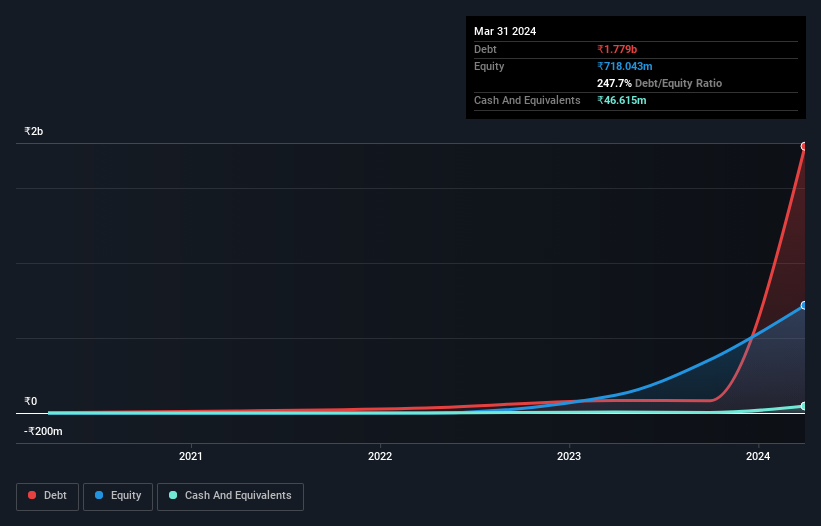- India
- /
- Telecom Services and Carriers
- /
- NSEI:SARTELE
SAR Televenture (NSE:SARTELE) Has A Pretty Healthy Balance Sheet

The external fund manager backed by Berkshire Hathaway's Charlie Munger, Li Lu, makes no bones about it when he says 'The biggest investment risk is not the volatility of prices, but whether you will suffer a permanent loss of capital.' It's only natural to consider a company's balance sheet when you examine how risky it is, since debt is often involved when a business collapses. We note that SAR Televenture Limited (NSE:SARTELE) does have debt on its balance sheet. But is this debt a concern to shareholders?
When Is Debt Dangerous?
Debt and other liabilities become risky for a business when it cannot easily fulfill those obligations, either with free cash flow or by raising capital at an attractive price. If things get really bad, the lenders can take control of the business. While that is not too common, we often do see indebted companies permanently diluting shareholders because lenders force them to raise capital at a distressed price. Of course, the upside of debt is that it often represents cheap capital, especially when it replaces dilution in a company with the ability to reinvest at high rates of return. The first thing to do when considering how much debt a business uses is to look at its cash and debt together.
See our latest analysis for SAR Televenture
What Is SAR Televenture's Net Debt?
The image below, which you can click on for greater detail, shows that at March 2024 SAR Televenture had debt of ₹1.78b, up from ₹83.9m in one year. However, it does have ₹46.6m in cash offsetting this, leading to net debt of about ₹1.73b.

How Strong Is SAR Televenture's Balance Sheet?
According to the last reported balance sheet, SAR Televenture had liabilities of ₹151.5m due within 12 months, and liabilities of ₹1.79b due beyond 12 months. Offsetting these obligations, it had cash of ₹46.6m as well as receivables valued at ₹2.43b due within 12 months. So it can boast ₹535.1m more liquid assets than total liabilities.
This short term liquidity is a sign that SAR Televenture could probably pay off its debt with ease, as its balance sheet is far from stretched.
In order to size up a company's debt relative to its earnings, we calculate its net debt divided by its earnings before interest, tax, depreciation, and amortization (EBITDA) and its earnings before interest and tax (EBIT) divided by its interest expense (its interest cover). Thus we consider debt relative to earnings both with and without depreciation and amortization expenses.
Strangely SAR Televenture has a sky high EBITDA ratio of 9.8, implying high debt, but a strong interest coverage of 72.7. This means that unless the company has access to very cheap debt, that interest expense will likely grow in the future. Notably, SAR Televenture's EBIT launched higher than Elon Musk, gaining a whopping 248% on last year. There's no doubt that we learn most about debt from the balance sheet. But it is SAR Televenture's earnings that will influence how the balance sheet holds up in the future. So if you're keen to discover more about its earnings, it might be worth checking out this graph of its long term earnings trend.
Finally, a company can only pay off debt with cold hard cash, not accounting profits. So it's worth checking how much of that EBIT is backed by free cash flow. During the last three years, SAR Televenture burned a lot of cash. While that may be a result of expenditure for growth, it does make the debt far more risky.
Our View
SAR Televenture's conversion of EBIT to free cash flow was a real negative on this analysis, as was its net debt to EBITDA. But like a ballerina ending on a perfect pirouette, it has not trouble covering its interest expense with its EBIT. When we consider all the elements mentioned above, it seems to us that SAR Televenture is managing its debt quite well. But a word of caution: we think debt levels are high enough to justify ongoing monitoring. The balance sheet is clearly the area to focus on when you are analysing debt. But ultimately, every company can contain risks that exist outside of the balance sheet. Be aware that SAR Televenture is showing 4 warning signs in our investment analysis , and 3 of those make us uncomfortable...
If you're interested in investing in businesses that can grow profits without the burden of debt, then check out this free list of growing businesses that have net cash on the balance sheet.
New: Manage All Your Stock Portfolios in One Place
We've created the ultimate portfolio companion for stock investors, and it's free.
• Connect an unlimited number of Portfolios and see your total in one currency
• Be alerted to new Warning Signs or Risks via email or mobile
• Track the Fair Value of your stocks
Have feedback on this article? Concerned about the content? Get in touch with us directly. Alternatively, email editorial-team (at) simplywallst.com.
This article by Simply Wall St is general in nature. We provide commentary based on historical data and analyst forecasts only using an unbiased methodology and our articles are not intended to be financial advice. It does not constitute a recommendation to buy or sell any stock, and does not take account of your objectives, or your financial situation. We aim to bring you long-term focused analysis driven by fundamental data. Note that our analysis may not factor in the latest price-sensitive company announcements or qualitative material. Simply Wall St has no position in any stocks mentioned.
About NSEI:SARTELE
SAR Televenture
Provides telecommunication solutions to telecom network operators in India.
Proven track record with adequate balance sheet.
Market Insights
Community Narratives



